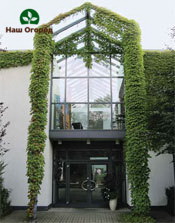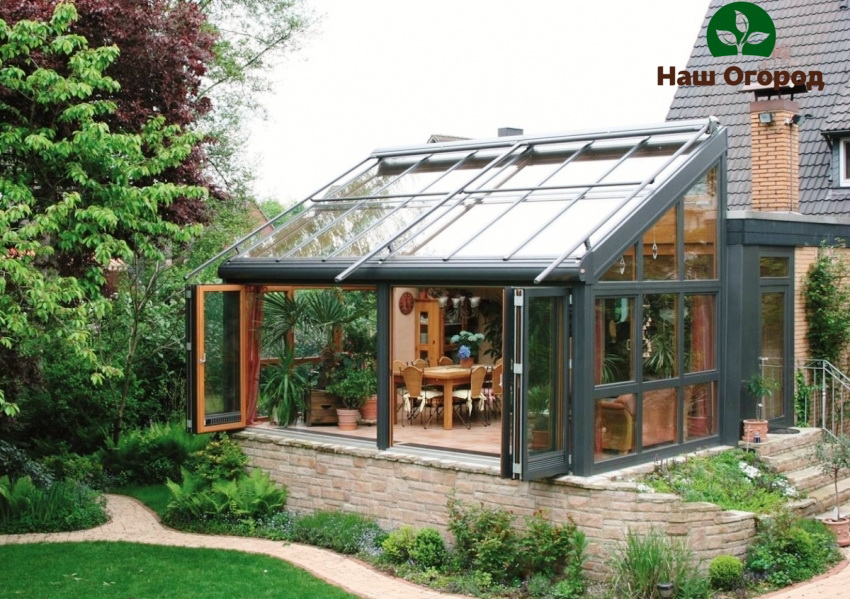How to create an "Eternal Summer" in winter
Content:
When we mention “eternal summer”, we recall the tropical climate, hot countries, where there is never a winter, where there is always a harvest, the vegetation does not fall asleep in anticipation of a warm spring and summer ... But what if you try to arrange an eternal garden by artificial means? Well, in this case, you have to try a little and collect the necessary information. The so-called winter garden involves the creation of an artificial microclimate for plants and crops in the winter. A bit like a greenhouse and a year-round greenhouse, right? However, unlike these buildings, a winter garden can be a pleasant addition even in urban conditions. The main thing is to follow the rules of its arrangement. The range of such designs is incredibly wide and is capable of realizing a variety of design solutions.
Depending on the layout and placement options of the winter garden, there are mainly two types of structures:
Built-in winter garden

The most practical in terms of saving space on the territory, but requiring design at an early stage, the built-in winter garden becomes a suitable option for spacious residential buildings. The complexity of this type lies in the fact that the finished house is hardly suitable for placement - it is necessary to rethink the ventilation system, which provides free air flows in the garden, the irrigation system for plants, as well as the load on the common foundation. It is recommended to consider this option only at the beginning of construction.
Attached winter garden
Winning in terms of the convenience of organization and construction, the attached winter garden does not require additional territory inside the house, although it consumes an additional total, in some cases it will be necessary to expand the existing space for correct planning. It is possible to organize an extension as a passage between the house and the outside space. It is also worth noting that this type of winter garden does not provide for the use of additional heating, because heating will come mainly from the house. Unfortunately, in the autumn and winter seasons, the air temperature will be lower, but still it is suitable for certain types of plants. This type of attached winter garden is called a buffer garden.

It is quite possible to avoid the described disadvantages if you refuse to go outside in the extension. In this case, the inside will ensure the maintenance of a stable temperature regime, as well as the moisture level necessary for the plants. It should be remembered about the optimal size of the building - no more than 15 square meters.
Construction features
As a rule, the construction of such a complex structure as a winter garden should be entrusted to specialists. Here, in contrast to the same greenhouse, the arrangement and comfort elements for both plants and humans are much more developed. If desired, the winter garden can be combined with a swimming pool, relaxation room, study, and so on.
The first thing you should pay attention to is a large glazing area to provide plants with sunlight, the required height of the room (about 3 meters), the calculation of the correspondence between the loads of the foundation and the scale of filling the winter garden.
The material used in the construction process must be reliable and durable in order to ensure the stability of the structure. It can be wood, aluminum and steel. The strong frame of the winter garden, coupled with the use of heat-insulating materials, will provide adequate protection against the penetration of cold, drafts and snow inside.It is also necessary to organize sufficient lighting of the space, a system of protection from the sun during the period of climatic loads and a high concentration of its rays in the direction of the plantings.
Ventilation should be provided by exhaust systems, sunroofs and free-opening windows. It is recommended to arrange additional heating of the gutters to facilitate snow removal in winter.
When it comes to heating, the simplest option would be to use oil-fired heaters that run on electricity. However, you should beware of excessive dryness of the air, and if this option does not suit you, it is recommended to use special air conditioners that have the functionality of heating and humidifying the air.
Selection of plants
Basically, for placement in the winter garden, plants are used that can adapt to growth in containers such as a cough, pots, and a flower girl. Provided there is sufficient free space, you can organize an embankment of soil - an imitation of garden beds and plantings. Plants from different climatic zones should not be placed in the same space, requiring a completely different, individual approach.
According to the content of plants, winter gardens can be divided into "tropical" and "subtropical". The first assumes the maintenance of crops that need an average temperature in the range of 18 to 26 degrees, examples are various orchids, ficuses, begonias, etc. The subtropical type is intended for plants, the optimal temperature for which is considered to be 12-18 degrees - citrus fruits, pomegranates are ideal , junipers, etc.
The winter garden is a truly amazing invention of man, capable of sheltering wildlife from severe cold and frost, even if by artificial means. Having thought over the design, arrangement and without neglecting the care of plants, you can create your own piece of paradise that will not fade throughout the year!

